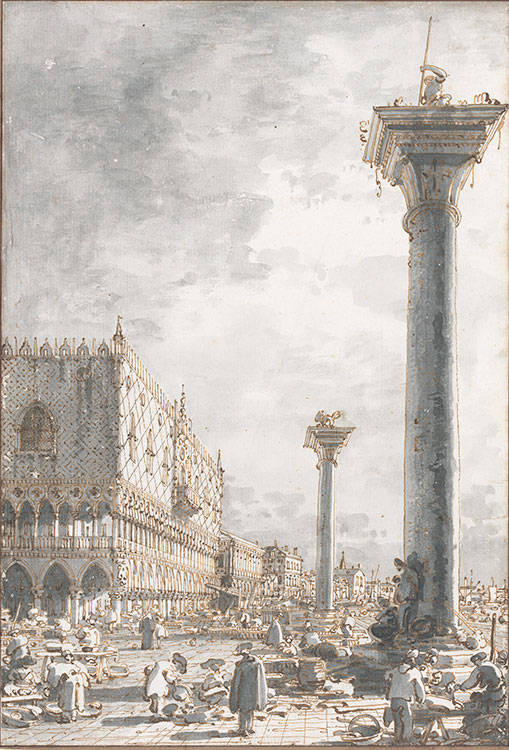
A native of Venice, Canaletto specialized in charmingly descriptive views of the city, which were highly sought after by European aristocrats traveling to Italy on the Grand Tour. This carefully structured landscape places the viewer amid a busy market at the Molo, a pier adjacent to the Doge’s Palace, seen at left. The meticulously described architectural features of the palace contrast with the calligraphic, somewhat abstracted rendering of figures populating the foreground. The drawing exemplifies Canaletto’s late work in its combination of brown ink and gray wash and his use of the paper’s white reserves to evoke sunlight playing over masonry.
Giovanni Antonio Canal, called Canaletto
Italian, 1697–1768
The Riva degli Schiavoni seen from the market at the pier, after 1755
Pen and iron- gall ink, and brush and gray wash, over traces of graphite
The Art Institute of Chicago, gift of Richard and Mary L. Gray; 2019.836
Gray Collection Trust, Art Institute of Chicago
Photography by Jamie Stukenberg, Professional Graphics Inc.
John Marciari: Canaletto is most famous, of course, for his painted views of Venice, but he also produced many highly finished drawings, which, though reduced to the white of the page, brown ink lines, and gray wash, have all the life of his colorful paintings. In this example, he takes one of the most recognizable sights of Venice, a view of the Doge's Palace at left, the columns of St. Theodore and St. Mark, and the Piazza de San Marco, and the distant view along the Riva degli Schiavoni. Rather than give a stately placid depiction, however, Canaletto animates the scene in unexpected ways by including the disarray of market stalls in the foreground, for example, and by distorting the perspective so that the deeply shadowed column of St. Theodore towers in the foreground, a notable contrast to the brightly lit façade of the palace, but one echoed by the dark clouding sky. While the profusion of detail speaks to the careful planning of the drawing, it is interesting to observe just how schematic Canaletto's forms are, especially in his late work. He had a seemingly magical ability to create wonderfully expressive figures with little more than a squiggle of line and a few dots of wash.
